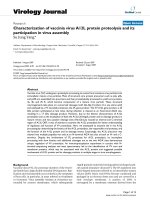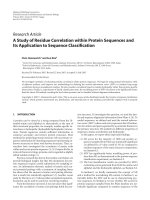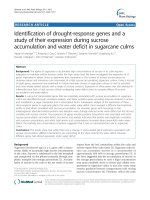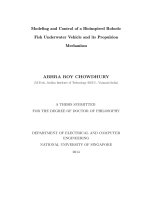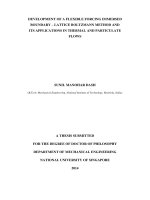STUDY OF n NITROSODIMETHYLAMINE (NDMA) FORMATION POTENTIAL AND ITS REMOVAL IN TREATED EFFLUENT BY UV h2o2 PROCESS
Bạn đang xem bản rút gọn của tài liệu. Xem và tải ngay bản đầy đủ của tài liệu tại đây (2.5 MB, 108 trang )
STUDY OF N-NITROSODIMETHYLAMINE (NDMA)
FORMATION POTENTIAL AND ITS REMOVAL IN
TREATED EFFLUENT BY UV/H2O2 PROCESS
WANG QI
B.Eng. (Hons.), NUS
A THESIS SUBMITTED
FOR THE DEGREE OF MASTER OF ENGINEERING
DEPARTMENT OF CIVIL AND ENVIRONMENTAL
ENGINEERING
NATIONAL UNIVERSITY OF SINGAPORE
2013
DECLARATION
I hereby declare that this thesis is my original work and it has been written by me in its
entirety. I have duly acknowledged all the sources of information which have been used
in the thesis.
This thesis has also not been submitted for any degree in any university previously.
___________________________
Wang Qi
22 March 2013
ACKNOWLEDGEMENTS
I would like to express my sincere thanks and gratitude to Associate Professor HU
Jiangyong for her continuous guidance, supervision and encouragement throughout the
master degree study. Her timely and insightful advice led me to this completion of the
dissertation.
I would as well thank research fellow CHU Xiaona, LIM Fang Yee for their help and
advice throughout the research; to Ms TAN Xiaolan, Ms LEE Leng Leng and Mr S.G.
Chandrasegaran for their assistance and guidance on experiment set-up, sample analysis
and chemical purchase; and to fellow research students for their companionship and
assistance.
Finally I would like to thank my parents for their great support throughout my study and
my closest friends for their inspiration and encouragement.
i
TABLE OF CONTENTS
SUMMARY ....................................................................................................................... iv
LIST OF TABLES ............................................................................................................. vi
LIST OF FINGURES ....................................................................................................... vii
LIST OF PLATES .............................................................................................................. x
NOMENCLATURES ........................................................................................................ xi
CHAPTER 1 INTRODUCTION ........................................................................................ 1
1.1 Background ............................................................................................................... 1
1.2 Project objectives and scope of study ....................................................................... 3
1.3 Outline of the thesis .................................................................................................. 4
CHAPTER 2 LITERATURE REVIEW ............................................................................. 5
2.1 NDMA as emerging DBPs........................................................................................ 5
2.1.1 Background ........................................................................................................ 5
2.1.2 NDMA formation............................................................................................... 7
2.1.3 NDMA occurrence in water environment .......................................................... 9
2.1.4 NDMA precursors ............................................................................................ 11
2.1.5 Current research on NDMA removal methods ................................................ 12
2.2 Dissolved organic matter (DOM) ........................................................................... 13
2.2.1 DOM characterization ...................................................................................... 13
2.2.2 Correlation between NDMAFP and DOM ...................................................... 18
2.2.3 DOM removal .................................................................................................. 19
2.3 UV/H2O2 AOP process ........................................................................................... 20
2.3.1 AOP background .............................................................................................. 20
2.3.2 UV/H2O2 mechanism ....................................................................................... 22
2.3.3 Key affecting factors ........................................................................................ 22
2.3.4 NDMA precursor removal by UV/H2O2 .......................................................... 28
CHAPTER 3 MATERIALS AND METHODS................................................................ 29
3.1 Introduction ............................................................................................................. 29
3.2 Experiment design part 1: NDMA formation potential and precursors study ........ 29
3.2.1 Experiment design ........................................................................................... 29
3.2.2 Experiment conditions ..................................................................................... 30
3.3 Experiment design part 2: UV/H2O2 effect on DOM and NDMAFP removal ....... 32
3.3.1 System set-up ................................................................................................... 32
ii
3.3.2 Wastewater characteristics ............................................................................... 35
3.3.3 Experiment design ........................................................................................... 35
3.4 Measurement and analysis method ......................................................................... 36
3.4.1 NDMA detection and analysis ......................................................................... 36
3.4.2 Free chlorine and total chlorine ....................................................................... 38
3.4.3 TOC and TN .................................................................................................... 39
3.4.4 Nitrate, Nitrite and Ammonium ....................................................................... 40
3.4.5 LC-OCD-OND ................................................................................................. 40
3.4.6 DON ................................................................................................................. 41
CHAPTER 4 RESULTS AND DISCUSSIONS ............................................................... 42
4.1 NDMAFP study results ........................................................................................... 42
4.1.1 NDMA formation kinetics and formation potential ......................................... 42
4.1.2 Organic precursor analysis ............................................................................... 45
4.1.3 Relationship between organic precursors and NDMAFP ................................ 49
4.2 Results of UV/H2O2 system I .................................................................................. 53
4.2.1 DOM removal .................................................................................................. 53
4.2.2 NDMAFP removal ........................................................................................... 59
4.3 Results of UV/H2O2 system II................................................................................. 60
4.3.1 DOM removal .................................................................................................. 60
4.3.2 NDMAFP removal ........................................................................................... 69
CHAPTER 5 CONCLUSIONS AND RECOMMENDATIONS ..................................... 77
5.1 Conclusions ............................................................................................................. 77
5.2 Recommendations ................................................................................................... 78
5.2.1 Improvement on NDMA detection .................................................................. 78
5.2.2 Improvement on UV/H2O2 process .................................................................. 79
5.2.3 Study on wastewater characteristics ................................................................ 79
BIBLIOGRAPHY ............................................................................................................. 80
APPENDICES .................................................................................................................. 84
Appendix 1 List of toxic DBPs ..................................................................................... 84
Appendix 2 Table of potential NDMA precursors........................................................ 88
Appendix 3 Membrane bio-reactor specification.......................................................... 93
Appendix 4 Activated sludge process specification ..................................................... 94
iii
SUMMARY
NDMA formation from treated wastewater is one of the concerns in water reuse. NDMA
is a carcinogenic compound and can be formed at a level significantly higher than the
level in drinking water quality guidelines. In order to better control NDMA in water, it is
important to study NDMA formation potential (NDMAFP) and NDMAFP removal
technology. This study focused on NDMAFP in wastewater treated effluent and
NDMAFP removal by UV/H2O2 technology.
Experiments were carried out to measure NDMAFP and characterize NDMA organic
precursors. This aimed to investigate relationship between organic precursors and
NDMAFP. Followed by this, UV/H2O2 system was designed and tested on the removal
effect on both organic precursors and NDMAFP. Two types of wastewater treated
effluents were selected to represent effluents with different organic compositions:
activated sludge process (ASP) effluent and membrane bio-reactor (MBR) effluent.
Experiment results showed similar NDMA formation kinetics between ASP and MBR
effluents, with rapid increase in first two days followed by a plateau. NDMAFP was
between 240 to 400ng/L. Results indicated no correlation (R2 = 0.16) between dissolved
organic nitrogen (DON) and NDMAFP. Weak correlation (R2 = 0.45) was however
observed between DON in molecules with molecular weight smaller than 500Da and
NDMAFP. In batch experiment, UV/H2O2 system consisted of low pressure ultra-violet
(LPUV) with intensity of 2mW/cm2 and H2O2 dosage at the magnitude of 100ppm.
Results showed efficient dissolved organic carbon (DOC) removal, with 70% removal in
one hour. DON removal was less efficient, with 30% removal. 80% of NDMAFP in ASP
iv
effluent was removed within one hour. This showed potential feasibility of applying
UV/H2O2 to remove NDMAFP in wastewater treated effluent. However, no NDMAFP
removal was discovered in MBR effluent. This indicated that NDMAFP removal was
water specific. During UV/H2O2 treatment of ASP effluent, generation of intermediate
NDMA precursors was observed. No correlation between DOC (R2 = 0.02) or DON (R2 =
0.002) and NDMAFP was discovered. This brought the attention that DOC or DON
cannot be used as an indicator for NDMAFP during UV/H2O2 treatment. At the same
time, sufficient oxidation should be provided to lower intermediate NDMA precursors
and to achieve NDMAFP removal.
v
LIST OF TABLES
Table 2.1 Physico-Chemical properties of NDMA ............................................................. 6
Table 2.2 Guideline level of NDMA ................................................................................ 10
Table 2.3 DON compounds in municipal wastewater effluent ......................................... 16
Table 2.4 Comparison of H2O2/O3, O3/UV, and H2O2/UV AOP processes ...................... 21
Table 2.5 Main difference between LP and MP mercury UV lamps ................................ 23
Table 3.1 Water quality parameters for wastewater treated effluents ............................... 31
Table 3.2 pH and UV transmittance for ASP and MBR effluents .................................... 35
Table 4.1 DOC and DON composition in each fraction in ASP and MBR effluents ....... 50
Table 4.2 Comparison of DOC and DON composition in ASP and MBR effluents ........ 66
vi
LIST OF FINGURES
Figure 2.1 Chemical structure of NDMA ........................................................................... 6
Figure 2.2 Typical NDMA concentrations in various water bodies ................................... 9
Figure 2.3 Classification of DOM based on DOC fractionation ....................................... 14
Figure 2.4 Chromatogram of surface water (River Pfinz, Karlsruhe, Germany) with
responses for organic carbon detection (OCD), UV-detection at 254 nm (UVD) and
organic nitrogen detection (OND). A: biopolymers, B: humic substances, C: building
block, D: low molecular-weight acids, E: low molecular-weight neutrals (LMW), F:
nitrate and G: ammonium. ................................................................................................ 17
Figure 2.5 Emission spectrum of a MP-lamp (
pretreated natural water (
Lambert-Beer law) (
) and the absorptions of a commonly
) and a 10mg/L H2O2 solution (according to the
). Composition of natural water: DOC content: 3.6 mg/L C;
[NO3-]: 11.2 mg/L ............................................................................................................. 24
Figure 2.6 Emission spectrum of a LP-lamp (
pretreated natural water (
Lambert-Beer law) (
) and the absorptions of a commonly
) and a 10mg/L H2O2 solution (according to the
). Composition of natural water: DOC content: 3.6 mg/L C;
[NO3-]: 11.2 mg/L ............................................................................................................. 25
Figure 3.1 Schematic chart of experiment design part 1................................................... 30
Figure 3.2 Schematic diagram of UV/H2O2 system I ....................................................... 33
Figure 3.3 Schematic diagram of UV/H2O2 system II ...................................................... 33
Figure 4.1 NDMA formation vs reaction time for selected wastewater samples ............. 43
Figure 4.2 Comparison of NDMAFP of ASP and MBR effluents ................................... 44
Figure 4.3 NDMA formation study of secondary effluent in Australia (Farréet al., 2010)
.......................................................................................................................................... 45
Figure 4.4 OCD chromatographs of selected wastewater samples ................................... 47
Figure 4.5 OND chromatographs of selected wastewater samples ................................... 48
Figure 4.6 NDMAFP and normalized NDMAFP in different wastewater samples.......... 49
Figure 4.7 Correlation between NDMAFP and organic precursors in secondary effluents
.......................................................................................................................................... 51
Figure 4.8 Correlation between NDMAFP and DON associated with four fractions in
secondary effluents ........................................................................................................... 52
Figure 4.9 DOC degradation profiles of unfiltered ASP effluent under UV/H2O2 system I
with different H2O2 dosages .............................................................................................. 54
vii
Figure 4.10 Comparison of DOC degradation profiles of unfiltered and filtered ASP
effluents under UV/H2O2 system I ([H2O2] = 200 ppm) ................................................... 54
Figure 4.11 DOC degradation profiles of filtered ASP effluent over the extended reaction
time under UV/H2O2 system I ([H2O2] = 200 ppm) .......................................................... 55
Figure 4.12 OCD chromatography of filtered ASP effluent treated by UV/H2O2 system I
([H2O2] = 200 ppm) .......................................................................................................... 56
Figure 4.13 DON degradation profiles of filtered ASP effluent under UV/H2O2 system I
([H2O2] = 200 ppm) .......................................................................................................... 57
Figure 4.14 OND chromatography of filtered ASP effluent under UV/H2O2 system I
([H2O2] = 200 ppm) .......................................................................................................... 58
Figure 4.15 Effect of UV/H2O2 system I on NDMAFP in ASP effluent ([H2O2] = 200
ppm) .................................................................................................................................. 59
Figure 4.16 DOC degradation profiles of ASP effluent under UV/H2O2 system II .......... 62
Figure 4.17 DOC degradation profiles in four DOM fractions in ASP effluent under
UV/H2O2 system II ([H2O2] = 100 ppm)........................................................................... 63
Figure 4.18 DON degradation profiles of ASP effluent under UV/H2O2 system II ......... 64
Figure 4.19 DON degradation profiles in four DOM fractions in ASP effluent under
UV/H2O2 system II ( [H2O2] = 100 ppm).......................................................................... 65
Figure 4.20 Comparison of DOC and DON removal in ASP and MBR effluents ........... 67
Figure 4.21 DOC and DON degradation profiles for four DOM fractions in MBR effluent
under UV/H2O2 system II ................................................................................................. 68
Figure 4.22 NDMAFP of ASP effluent under UV/H2O2 system II .................................. 69
Figure 4.23 NDMAFP per DON of ASP effluent under UV/H2O2 system II ................... 70
Figure 4.24 Ratio of NDMAFP and initial NDMAFP of ASP effluent under UV/H2O2
system II ............................................................................................................................ 70
Figure 4.25 DOC degradation profiles in four DOM fractions in ASP effluent under
UV/H2O2 system II ([H2O2] = 50 ppm)............................................................................. 72
Figure 4.26 DON degradation profiles in four DOM fractions in ASP effluent under
UV/H2O2 system II ( [H2O2] = 50 ppm)............................................................................ 72
Figure 4.27 Comparison of DOC in four DOM fractions in ASP effluent with different
H2O2 dosages .................................................................................................................... 73
Figure 4.28 Comparison of DON in four DOM fractions in ASP effluent with different
H2O2 dosages .................................................................................................................... 74
Figure 4.29 NDMAFP of MBR effluent under UV/H2O2 system II ([H2O2] = 100 ppm) 76
viii
Figure 4.30 NDMAFP of MBR effluent under UV/H2O2 system II with different H2O2
dosages over 60 minutes ................................................................................................... 76
ix
LIST OF PLATES
Plate 3.1 UV/H2O2 system I set-up ................................................................................... 34
Plate 3.2 UV/H2O2 system II set-up .................................................................................. 34
Plate 3.3 Experiment set up for SPE procedure ................................................................ 37
x
NOMENCLATURES
AOP
Advanced Oxidation Process
BB
Building Block
BP
Bio-polymers
DOC
Dissolved Organic Carbon
DOM
Dissolved Organic Matter
DON
Dissolved Organic Nitrogen
GC
Gas Chromatography
HS
Humic Substance
LC
Liquid Chromatography
LMW
Low Molecular Weight
LPUV
Low Pressure Ultraviolet
MPUV
Medium Pressure Ultraviolet
MS
Mass Spectrometry
NDMA
N-nitrosodimethylamine
NDMAFP NDMA Formation Potential
SPE
Solid Phase Extraction
xi
CHAPTER 1 INTRODUCTIONRODUCTION
1.1 Background
Clean drinking water supply is a challenging issue for the society. Currently, water
shortage and pollution problem is affecting human health and development. With
population increase and urbanization, the problem is becoming severer. One of the
strategies to face the problem is to look for alternative water supply from water reuse and
reclamation (Fujioka et al., 2012). However, due to complex composition of wastewater,
it is important to ensure reclaimed water quality. In current practice, treated water is
discharged into natural environment before consumption to reduce contamination levels
(Water Reuse: Potential for Expanding the Nation's Water Supply through Reuse of
Municipal Wastewater (2012), 2012). Future approach is leading to directly restore
treated wastewater to portable quality (Shannon et al., 2008). Both current and future
situations require stringent regulation and reliable engineering system to ensure drinking
water quality.
NDMA is one of the emerging concerning compounds affecting drinking water quality.
This carcinogenic compound poses health threat to human at very low concentration:
according to USEPA, 0.7ng/L NDMA in drinking water yields 10-6 lifetime cancer risk.
First incident of NDMA in drinking water supply dated in 1998 in California. In this case,
high level of NDMA was detected in places where treated wastewater was reused
indirectly for potable purpose. It was later discovered that NDMA was produced from
chlorination of wastewater. To response, California Department of Public Health (CDPH)
established interim action level of 10ng/L (CDPH, 2011). Moreover, Ontario Ministry of
the Environment (MOE) in Canada set Interim Maximum Acceptable Concentration for
1
NDMA as 9ng/L (MOE, 2000). The World Health Organization (WHO) established a
guideline value of 100ng/L (WHO, 2006).
With stringent regulation on NDMA, it is important to study and therefore control
NDMA formation in treated wastewater. The challenges associated include
characterization of NDMA precursors and evaluation of NDMA removal technology.
Characterization of NDMA precursors is important for treatment process selection.
Dissolved organic matters (DOM) are the main precursors. NDMA pathway studies
discovered dimethylamine (DMA) as most effective organic nitrogen precursor (Mitch et
al., 2003b). Organic nitrogen compounds with DMA and DMA functional group in
wastewater also contribute to NDMA precursors. However, DMA is not the only source
(Mitch et al., 2003). Other precursors reported include dithiocarbamate and nitrogencontaining cationic polyelectrolytes (Weissmahr & Sedlak, 2000). However, studies
reported that majority of NDMA precursors in treated effluent are unknown compounds
other than DMA (Mitch & Sedlak, 2004; Sedlak & Kavanaugh, 2005). Therefore it is
important to characterize wastewater derived DOM and to better understand NDMA
precursors.
NDMA removal consists of the removal of NDMA and NDMA precursor. Many studies
have addressed the issue of NDMA removal. Ultraviolet (UV) photolysis is one
established method, where UV light cleaves the N-N bond and breaks NDMA into nitrite
and DMA (U.S.EPA, 2008). In comparison, fewer studies have investigated treatment
process for NDMA precursor removal in wastewater treated effluent. Microfiltration
demonstrates moderate removal efficiency for NDMA precursors. Reverse osmosis can
reduce NDMA precursors by one order. Result is not available for UV effect on NDMA
2
precursor removal (Deeb et al., 2010). Preliminary research result has shown UV/H2O2
effect on NDMA precursor removal (Chen et al., 2010). However the performance may
be overestimated for wastewater treated effluent, due to experiments being performed on
surface water combined with wastewater treated effluent. The preliminary research only
chose one UV/H2O2 condition, different UV/H2O2 conditions and various treated
wastewater should be further studied.
1.2 Project objectives and scope of study
The main objective of this project is to study NDMA formation potential in treated
wastewater and to evaluate UV/H2O2 technology on NDMA precursor removal. The
study includes NDMA formation potential (NDMAFP) study, organic precursor
characterization and UV/H2O2 process evaluation.
The scope of the study is:
To establish NDMA detection method and to measure NDMAFP in treated
wastewater from two treatment processes
To characterize organic precursors and to study the relationship between organic
precursors and NDMAFP
To establish UV/H2O2 technology and to assess its removal effect on organic
precursors and NDMAFP in treated wastewater
3
1.3 Outline of the thesis
This thesis presents the study of NDMA formation potential and its removal in treated
wastewater. Chapter one and two illustrate concerns of NDMA in wastewater treatment,
characterization of organic precursors, and background of UV/H2O2 technology. Chapter
three presents methodology of the study and experiment design for both NDMAFP study
and UV/H2O2 technology evaluation. Chapter four presents experiment results and its
interpretation including NDMAFP for selected treated wastewater, correlation between
organic precursors and NDMAFP, UV/H2O2 effect on organic precursors and NDMAFP
removal. Chapter five concludes this study and presents recommendations for future
study on NDMAFP removal.
4
CHAPTER 2 LITERATURE REVIEW
2.1 NDMA as emerging DBPs
2.1.1 Background
Disinfection by-products (DBPs) are the compounds generated during disinfection
process in water treatment, when organic and inorganic matter in water reacts with
disinfectant. Depending on disinfection process, DBPs include chlorinated and nonchlorinated DBPs. Many DBPs are toxic and have adverse effect on human health. A list
of regulated and unregulated toxic DBPs (Richardson et al., 2007) is included in
appendix one.
In the forty years history of DBPs, trihalomethane (THM) and haloacetic acid (HAA)
were first discovered. They were regulated firstly in the United States. Water treatment
processes have then changed. Source water is controlled. Coagulation is added before
disinfection and THM and HAA levels are controlled. Other alternatives are applying
chloramines or use other oxidants as primary disinfectants.
In the past decade, new problems emerge. This includes: nitrification, formation of other
DBPs, nitrosamines and mobilization of lead. The most distinguish study in DBP recently
is the discovery of emerging DBPs. NDMA is one emerging DBP resulted from
chlorination and chloramination. Compared with DBPs discovered forty years ago, these
emerging DBPs in water are of much lower concentration (2 to 3 magnitudes lower), but
of much higher danger to human health (2 to 3 magnitudes higher). As mentioned in
5
chapter one, for NDMA, concentration associated with 10-6 cancer rate is 0.7ng/l;
however, the 10-6 cancer rate associated with bromodichloromethane, which is the most
dangerous of early discovered THMs, is 600ng/l. Given the high severity, NDMA has
received attention in both scientific community and water authority.
NDMA is a semi-volatile organic chemical. Molecular formula is (CH3)2N-NO and its
molecular mass is 74.08g/mol. It is a hydrophilic, polar compound. It was previously
used in production of liquid rocket fuel, antioxidants and softeners for copolymers. Its
chemical structure (Plumlee et al., 2008) is shown in Fig 2.1. The physical and chemical
properties are presented in Table 2.1 (Farréet al., 2010).
Figure 2.1 Chemical structure of NDMA
Table 2.1 Physico-Chemical properties of NDMA
Property
Value
CAS Number
62-75-9
Boiling point (oC)
151-154
Molecular weight (g/mol)
78.08
Hydrophobicity soil –Log KoC
1.079
Hydrophobicity water –Log Kow
-0.57
Vapour pressure (Pa)
1,080 (25 oC)
Henry’s law constant (Pa m3/mol)
3.34 (25 oC)
Density (kg/L)
1.006 (20 oC)
Solubility in water (g/L)
Miscible 100 (19 oC)
6
NDMA has been found in different media: air, water and soil. It is completely miscible in
water and does not adsorb to particles. This makes decontamination by adsorption
difficult. Other properties of NDMA include its high mobility in soil and probable
leaching into ground water. Under sunlight, NDMA breaks down quickly in air.
2.1.2 NDMA formation
Two possible formation pathways have been discovered: nitrosation and unsymmetrical
dimethylhydrazine (UDMH) oxidation (Mitch et al., 2003b). The former was observed in
NDMA formation in food production. The later was demonstrated to be responsible for
NDMA formation during water chlorination.
During nitrosation, nitrosyl cation is firstly formed from acidification of nitrite; then, it
reacts with dimethylamine to form NDMA. This is illustrated in the two reaction
equations below:
(
)
(
)
(
)
(
)
This reaction takes place most rapidly at pH 3.4. Under water and wastewater treatment
conditions, this reaction is too slow for the NDMA formation to occur.
Recent studies showed that the formation could take place when UDMH acted as an
intermediate (Mitch & Sedlak, 2002). Two steps mechanism was further developed, and
it corresponds with the phenomena of NDMA formation from monochloramine. This
7
mechanism is illustrated in the equations below. Firstly, monochloramine is formed from
ammonia and hypochlorite. Followed by this, monochloramine reacts with organic
nitrogen containing precursor to form UDMH. The product is further oxidized into
NDMA.
Step 1
(
)
(
)
(
)
(
)
(
)
Step 2
(
)
(
)
NDMA formation is generally slow. It was reported that the application of
monochloramine facilitated NDMA formation (Mitch et al., 2003b). Furthermore, it was
observed that hypochlorite alone could form NDMA by reacting with secondary amine.
This reaction rate is one order magnitude smaller than that of monochloramine (Mitch &
Sedlak, 2002).
In water and wastewater treatment, major factors that affect NDMA formation include
the following: pH, chloramine concentration, contact time, Cl/N ratio and treatment
process. Studies demonstrated that pH affected NDMA formation during chloramination
of DMA; the maximum reaction rate occurred between pH 6 and 8 (Mitch et al., 2003b).
With fixed DMA concentration, NDMA formation increases with the increase of
8
chloramine concentration. However, the formation reaches a plateau in the end. NDMA
formation increases with the increase of contact time and with the increase of Cl/N molar
ratio of chloramine. In terms of treatment process, dosing of chlorine or chloramines as
disinfectant is the direct source of NDMA formation. Amine containing resin or polymers
increase NDMA precursors and result in increase of NDMA formation.
2.1.3 NDMA occurrence in water environment
Representative values of NDMA detected in various water sources are shown in the
Figure 2.2. Normally, surface water without impact of industrial waste or wastewater
discharges has NDMA level less than 10 ng/L. However, secondary wastewater effluent,
as shown, has higher NDMA concentration: 100 to 1000 ng/L. It was observed that even
after advanced treatment, for instance microfiltration, reverse osmosis and UV
disinfection, chlorinated wastewater still contained NDMA concentration between 10 to
100 ng/L (Sedlak & Kavanaugh, 2005).
Figure 2.2 Typical NDMA concentrations in various water bodies
9
Surveys on NDMA in drinking water system have been carried out. In US, California
Department of Health Services examined 32 water treatment plants. The study showed
some raw waters contained NDMA. In Ontario, 179 water treatment plants were surveyed
for NDMA presence. The study confirmed the results from survey in California. It also
discovered that in chloraminated system, there was increase of NDMA concentration in
distribution system (Charrois et al., 2007). In Japan, national wide survey examined
NDMA in raw and finished waters. Concentration of NDMA in raw waters was detected
to be less than 10ng/L (Asami et al., 2009).
In respond to the occurrence of NDMA in drinking water, as mentioned in Chapter one,
regulatory authorities have established water quality guidelines and standards for NDMA.
It is summarized in Table 2.2 (Fujioka et al., 2012).
Table 2.2 Guideline level of NDMA
US EPA,
IRIS 10-6
risk level
(ng/L)
CDPH
10-6 risk
level
(ng/L)
CDPH
notification
level (ng/L)
Ontario MOE
interim
action level
(ng/L)
WHO
guideline
value
(ng/L)
ADWG
guidelin
e value
(ng/L)
0.7
3
10
9
100
100
AGWR
guideli
ne
value
(ng/L)
10
IRIS: Integrated Risk Information System
CDPH: California Department of Public Health
MOE: Ministry of the Environment
WHO: World Health Organization
ADWG: Australian Drinking Water Guidelines
AGWR: Australian Guidelines for Water Recycling
At present, not many water utilities are able to monitor NDMA concentration in their
product water. In the United States, screening focused on unregulated contaminants of
concern for future monitoring. Results from 1196 public water supplies showed NDMA
as the most frequently detected contaminant with a maximum concentration of 630ng/L
10
(USEPA, 2010). NDMA is very likely to be regulated in the coming years under the US
Safe Drinking Water Act (Roberson, 2010). This indicates the need to detect NDMA in
water supplies and to control NDMA precursors in recycled water.
2.1.4 NDMA precursors
Existence of NDMA precursors in wastewater has been documented. To measure the
quantity of NDMA precursors in water sample, the concept of NDMAFP was introduced.
NDMAFP refers to the maximum amount of NDMA formed. Mitch et al. (2003)
developed a method to measure NDMAFP by dosing excessive monochloramine into
water sample and leaving the reaction for 10 days period. In secondary wastewater
effluent in United States, Mitch et al. (2003) reported NDMAFP to be between 660 and
2000 ng/L. For secondary wastewater effluent in South East Queensland in Australia,
Farré et al. (2010) reported NDMAFP varied from 300 to 1000 ng/L. Sedlak and
Kavanaugh (2005) reported NDMAFP in domestic wastewater in California of ranging
from 25 to 55 μg/L (25,000 – 55,000 ng/L). They reported NDMAFP in an industrial
wastewater was 82.5 μg/L (82,500 ng/L).
As mentioned in chapter one, DMA is the most effective organic nitrogen precursors.
Organic compounds containing amine functional groups including DMA and tertiary
amines can be converted into NDMA during chloramination process. Mitch et al. (2003b)
measured DMA in primary wastewater effluent ranging between 20 to 80 μg/L. DMA
has been detected in human urine and feces as well as animal feces. Amines can also be
formed from microbiological degradation of amino acids. Other sources of DMA and
nitrogen containing organics precursors include resins used in water and wastewater
11


